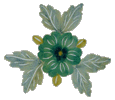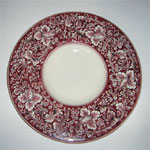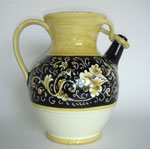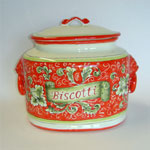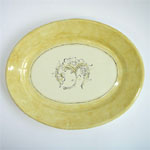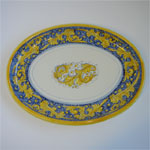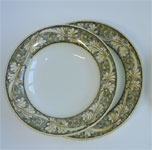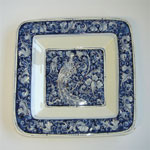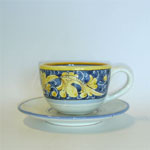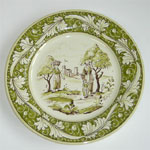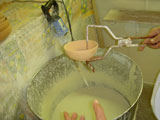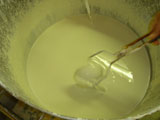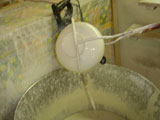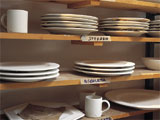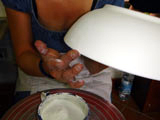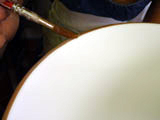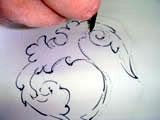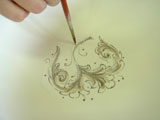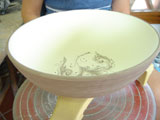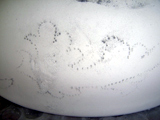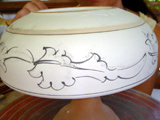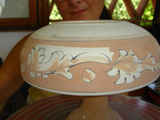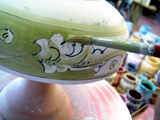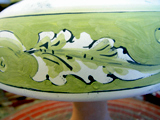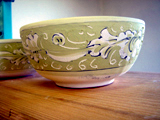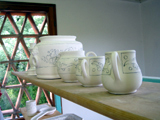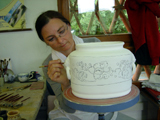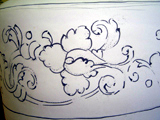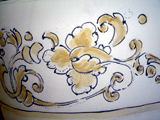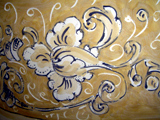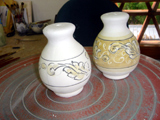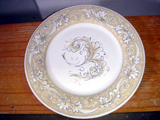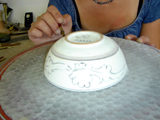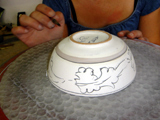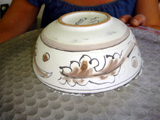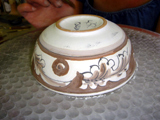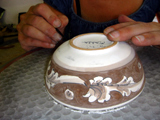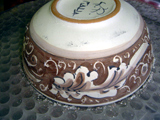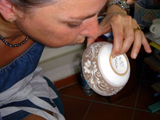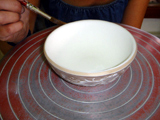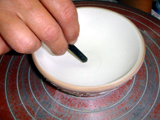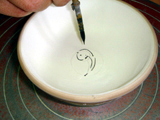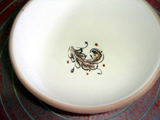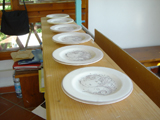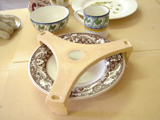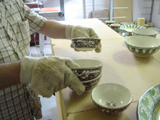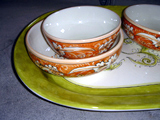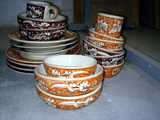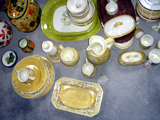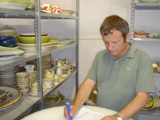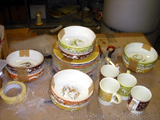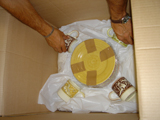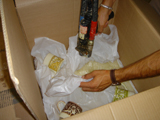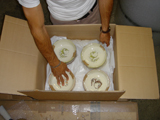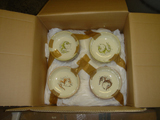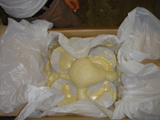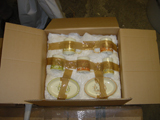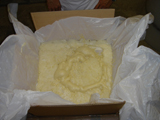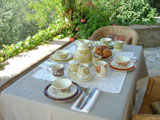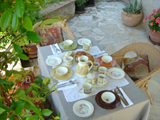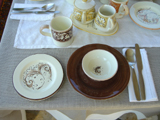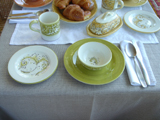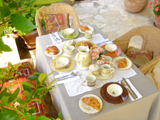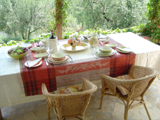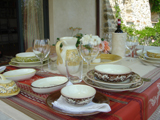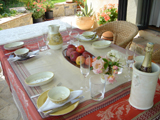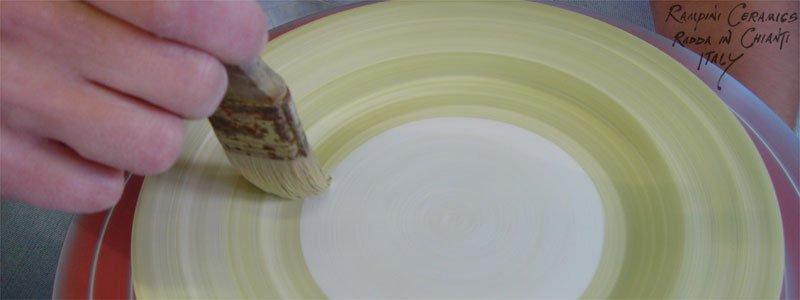
Manufacturing Ceramics at Rampini:
Follow work on a dinner set
from the bisque to the set table
Ciao, I am Fiona and I want to share what happens when an order arrives at Rampini Ceramics.
Mrs. A, a customer who already owns a Rampini set, sent me a detailed fax with a new order after having looked at our website and she made very clear choices. She wished to add two extra place settings to her set, two more chargers, two more dinner plates, side plates, bread plates, soup bowls, cereal bowls, espresso cups & saucers, pasta bowls, tea cups & saucers and some additional serving pieces – oval platters, pitchers and salad bowls.
Two years previously we had made a beautiful dinner set for Mrs. A. using the traditional Florentine pattern called Rinascimento (Renaissance) but personalizing it for her by changing the blue background to a gorgeous bottle green colour. Mrs. A. had just finished redecorating her dining room and the green was a tie in with her new light shades and drapes and the whole room looked fabulous ... I have seen the photos!
| The versatility of the Rinascimento (Renaissance) design |
As soon as her fax came through I opened a file for her. As our production is so tailored to customers’ requests I saw straight away that I was going to need her to send me some good quality close up photographs of some of the pieces that she already had in her collection. This way our painters could be sure to closely match her new dishes with what she already had! This is not at all unusual with repeat order customers, as it helps so much to have a good reference point from which to work.
I wrote to her explaining our current production time (at that moment the waiting list ran to about two months ... it happened to be quite a busy time!), the payment process and I requested the additional photographic information. At this point I wrote up a first draft of the order and put it in my 'pending' file as I waited to hear back from Mrs. A. She was quick off the mark and after my lunch break I already had a reply in my in-box. Great! I had some good photos and an interesting order to work with. I replied to Mrs. A. thanking her and reminding her of our production time - I don’t like for people to build up their hopes for a delivery date that cannot be met! Then, I hand wrote her order, attached the photographs and passed the order to my colleague Renzo for development and distribution.
Organizing the work
Buongiorno, I am Renzo and, once Fiona passes an order on to me, the first thing that I have to do is enter it into our accounts programme, the money part! From this point an interim invoice is processed and we can start producing the pottery. Every item in our range has a code to simplify the order development. I condense the order and then divide all the relevant pieces up among our artists. Some designs are only done by certain painters and the moment I see an order I instantly begin to think who will be doing what. In the case of Mrs. A.’s order I already knew that Nicoletta would be the artist doing this work. Once I have sorted out the order I call the head painter, Tania.
Ciao, my name is Tania and I spend at least half an hour every morning with Renzo going through the orders to be distributed among the painters. The girls wait for me to arrive in the studio and once they have the orders in their files they begin giving their requests for the shapes they need to our storeroom manager. I supervise this whole procedure and am always on hand to help the painters if they have any questions. I gave Nicoletta Mrs. A.’s order and the painters started gathering together the shapes needed to begin production.
Preparing the ceramics shapes
Ciao, I am Verim and I run the storeroom for all the shapes that we use in our pottery production. The painters let me know every morning what different pieces they need for their orders and I get everything together for them and take it all to the glazing laboratory. In this case Nicoletta asked me for a large variety of dishes and many serving pieces. It took me quite a while to get all the pieces needed for Mrs. A's order ready to transport to Pino for glazing.
| Glazing |
Hi, my name is Pino and I am in charge of the preparation of the ceramics, the glazing and ultimately the firing in the kiln. When Verim brings me all the shapes for the day I call the painters one by one and together we check that the pieces are correct and I put them on the corresponding shelf for each artist. This order was quite big and Nicoletta had both her designated shelves full of pieces to be prepared ... two of everything.
The first thing I do is to carefully sponge down each piece of pottery and set it out to dry naturally. This is to remove any dust and fine ceramic residue. Once the shape is dry, I dip-glaze it. This is a delicate part in the production process. I use specially designed long handled tongs to grip the pottery shapes and, with a smooth, fluid movement, I immerge the piece into a large vat full of liquid glaze and quickly extract it so not too much glaze coats the shape. I leave it again to dry completely, before calling the painters and letting them know that the ceramics are ready to be painted.
Painting
Salve, my name is Nicoletta and I am an artist at Rampini Ceramics. The order that I am going to tell you about was one that I particularly enjoyed. I remembered the original order for this customer well and I was very happy that she wished to add to her ceramics collection. The bottle green colour that she had requested was beautiful and it was a delight to paint using this shade of “verde” again. It is an unusual tone of green and I actually specially mixed the colours myself, testing one by one the shade until I obtained exactly what the customer needed. Pino let me know that the shapes were ready to be painted, so I looked up my records and followed the exact formula that I had devised 24 months ago. What a gorgeous colour! I was ready to begin.
| Nicoletta paints bowls of different shapes, ... |
Fiona had attached some photographs of the pottery that I had painted previously to the order form. It is so helpful to have a reference when adding to an already existing collection. This particular design is an old Florentine pattern and shows oak leaves gracefully circling around the ceramics. There are pieces of ceramics in museums around the world that show the originals of this design and it gives me huge pleasure to be recreating this Medici pattern.
| ... designs, ... |
When I have a larger sized order to do, I tend to start by painting the flat pieces so that I can get my “hand” into the pattern. In this case I had chargers, dinner plates, side and bread plates and pasta bowls! This design is quite time consuming and to paint just the flat pieces it was going to take me at least one days work. As I imagined by the time my lunch break came around I was through with the chargers and the bread plates and I had finished one pasta bowl and a side plate. I was on time with my production and the plates looked great.
Pino came up to the studio and took the pottery that I had already finished down stairs to the kiln room. By the end of the day I had finished painting all the flat items and Pino had everything downstairs ready to load into the kiln.
| ... colours, ... |
Next the additional serving pieces and the cups and saucers, both coffee and tea, were to be painted. Verim had sourced the pottery shapes and Pino had everything glazed and ready for me to paint.
I began with the oval platters. This is a difficult shape to paint as it is not round. The round shapes spin perfectly on the “turnino” that we position the ceramics on while they are being decorated. An oval needs care and precision when painting and the hardest part to get right is the symmetry! By the end of the day I had managed to do the two oval platters, the salad bowls and the two pitchers.
| ... more colours, ... |
The following day I painted the coffee cups and saucers and the teacups and saucers. It is very important to get the reduced dimensions right. The day before I had painted larger pieces and, going from a large platter to a tiny coffee cup, one has to pay particular attention. By the afternoon, the entire order was painted, and it was over to Pino to load up the kiln and let the firing process work its magic. My part of the production of these lovely plates was almost completed and now the only thing to do was wait for the best part ... the moment that the ceramics come hot out of the firing oven!
| ... and the smaller sizes, too. |
Firing
Hello, it is me again, Pino. When Nicoletta had finished this order, I brought everything down to the kiln and began the process of stacking and loading up the kiln. This is a very delicate job and I have to be extremely careful when I pick up the ceramics to place them in the oven.
The oven has a clay and ceramic structure internally and I stack it up, by constructing layer after layer on top of each other, using ceramic blocks to raise the layers to the required heights to accommodate the ceramics that are to be fired. It takes me a couple of hours to prepare the oven and the process is facilitated by the fact that I constructed the whole internal structure on a moveable trolley that I can then wheel into the inside of the kiln easily. Then, I close the door of the kiln tightly and seal it with an air lock. For our type of ceramics I always fire at a temperature of 940°-950° C (about 1700° F) which guarantees the maximum durability without compromising the quality of the colours. Then we wait!
Quality control
Ciao, Tania here. I am in charge of quality control and I closely inspect every piece of pottery that comes out of the kiln before I approve it and have it sent on to the next stage … the packing room. Due to the delicate nature of this work and the high standard that we want to maintain, I am very careful when checking over the still warm items that come out of the kiln. With hand glazed and hand painted ceramics some professional errors do occur.
| Firing and Quality Control |
There are some colours for example, that just do not fire well. Until 18 months ago we never painted anything using red ... it just was not giving us the quality results that we insist on and so we avoided this colour completely. We now have a wonderful red that we developed together with our colour professionals in Florence, but it is still a new entry on our colour chart. I look out for the infamous glaze bubbles and spotting which can occur. I have to decide what is going to be acceptable and what has to be re-made.
With this particular order we were lucky and everything came out of the kiln looking perfect. The dinner plates were absolutely beautiful and the green that we had custom-made for this customer had everyone very excited, as it was so deep and intense! My next job is to call one of our packers to come over to the kiln area and collect all the items that are to be packed.
Packing and shipping
| Packing |
Salve, my name is Verim, and I am in charge of packing the ceramics for shipping. Once I get the call from Tania, then I collect all the items of pottery and bring them to the packing room. With the help of the original order, that I collect from Fiona upstairs, I divide all the ceramics up and make sure that each shipment has all the pieces of pottery that it should have.
Firstly, I bubble wrap each individual piece, then I prepare the internal structure of the boxes. For the last ten years we have used very efficient liquid foam to pack our ceramics. Basically this substance is a liquid that upon contact with air becomes foam and it has proved its worth time and time again, as I am able to pack even our most delicate and fragile items of ceramics, send them to other continents and know that they will arrive intact!
| What it is all about ... |
I packed this entire order in four boxes. I also prepare a list of the contents of each box for Fiona, and weigh and measure each individual box for the shipping company so that they can calculate whereabouts on their transport planes they will pack the boxes. That is my part done and I enjoy knowing that within four or five days my carefully prepared boxes will be opened and the beautiful ceramics will have their definitive home.
Hello, Fiona, again. Well, that is about it for the order story. I let the customers know the tracking number of their shipments and wait to hear from them when the ceramics arrive at destination.
![]() For further information and to order contact@rampiniceramics.com.
For further information and to order contact@rampiniceramics.com.
Due to the characteristics of monitors the colours in images may vary from the original ceramics pieces.
Copyright © 2009 Rampini Ceramics (all text and images).
